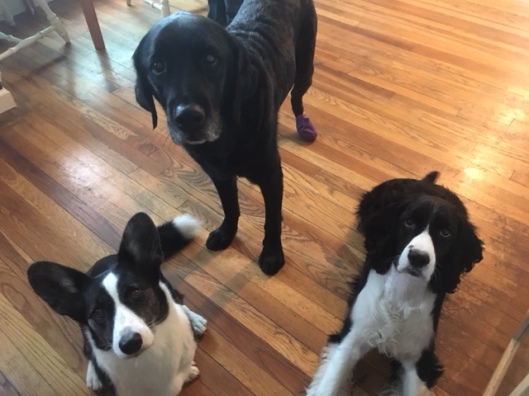Tags
*As of Feb 1, 2019 We’ve moved!* If you like this post please come on over to the new blog at https://www.maplewooddog.com/blog/ Where you can find all the archives you’ve read here plus new posts nearly every week! Hope you’ll join me over at the Maplewood Dog Blog. Thanks!

Regal, a liver color flat coated retriever tongue out smiling
It’s been a rough month around here. Between my gram passing away after a long fulfilling life and a few friends in the process of shifting into hospice care mentality for their geriatric dogs, it’s been a rough go of it. I’ve found myself asked more than usual my philosophy on end of life decisions for our canine companions.
Having been through it too many times with my own pets over the years and supported friends and clients through such difficult times with their dogs, at this point my philosophy is rather simple.
It boils down to this for me: what ever decision made is the right one.
Simple as that. I don’t care what your family thinks you should do, or your neighbors, or a vet, or even what you may have done with a past dog. As long as you feel you are doing as best you can to honor that individual dog and your relationship with them, any decision you make is the right one. Each relationship we have with a dog is an intensely personal and individual one and at the end of the day when such difficult decisions are made from a place of love, whatever decision made is the right one.
No one else has the right to judge you for any decisions made in such circumstances. There are so many factors emotional, financial, location, behavioral, physical, personality and more. None of which are ever the same for any case. Anyone expressing judgment or shoulds is saying more about their own fears, discomfort or insecurity than about you and your decisions surrounding your dog during such a difficult time.
For each of my dogs, I have based the decisions I’ve made on what I know of that individual dog, their personality, their way of going about life, their relationship with me, others and the world around them, plus whatever medical diagnosis they have, and the realities of our life situation at the time. Every single dog I’ve personally had to date, none of the end of life care decisions have been the same, yet all have so far felt right for that particular dog at that particular time.
And yup, I’ve had times where I’ve disagreed with the vets on our case in treatment approach, which may have been a wonderful approach with another dog, knowing my particular dog as I did, would have been a form of torture for him. So I found a vet team that would take more than my dogs diagnosis into consideration. instead of having 3 months of his version of torture followed by maybe an additional 4-6 months of life, we were able to have 6 months of palliative care and excellent quality of life the entire 6 months. A decision I’m glad I made for that specific dog, knowing with a different dog I may very well have made a completely different decision which would have then been right for that particular dog at that particular time.
Hopefully I won’t have to make such decisions again for my own pets for a good many years in the future, (knock on wood) but when the time comes I will do the best I can to do right by my dog and know that whatever decision I make will be from a place of intense caring and love. And I’m doing my best currently to support my friends going through such difficult decisions with their wonderful dogs knowing and believing fully whatever decisions they make are the right ones for them and their pets.

















